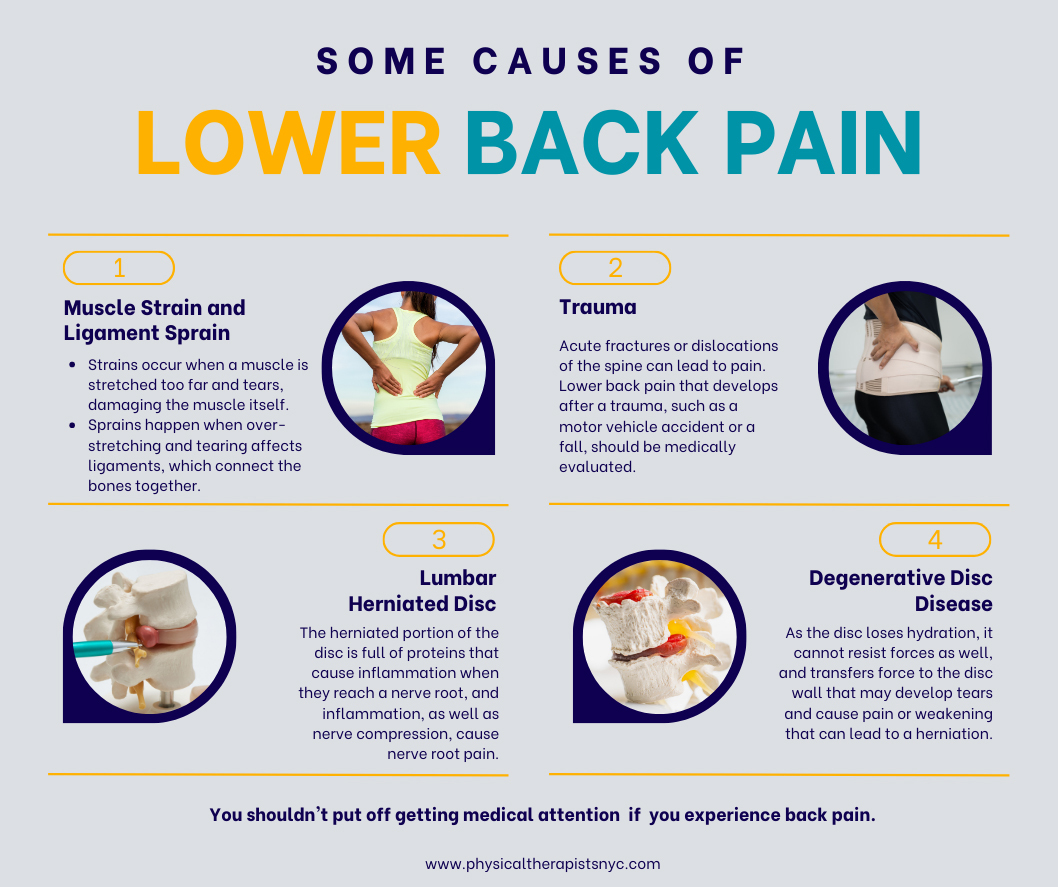Physical therapy for lower back pain or other types of spinal issues is the most effective first-line treatment that provides long-lasting results. No matter what is bothering you, whether it’s sprains, back strains, or more severe conditions or injuries like sciatica, degenerative disk disease, or a spinal fracture, Downtown Physical Therapists NYC will create a comprehensive recovery plan, and utilize cutting-edge treatment techniques, ensuring the best physical therapy outcomes.
Relieve the Pain in Your Back with Physical Therapy
Your back is a complex system of bones, joints, ligaments, and muscles. Back pain might be triggered by something traumatic, such as an injury, or it can be caused by simply lifting incorrectly. The causes are vast and varied, but the good news is that most back pain improves with rest and at-home care. Physical therapy back exercises at our offices will help you achieve an even better outlook.
Meeting with one of our top-rated back pain specialists at Physical Therapists NYC is one of the best steps you can take to prevent back pain and recover from back injuries. Our goal is not just to help you recover from back pain, but also to develop a back physical therapy approach that will help you avoid future injuries and discomfort.
What are the Symptoms of Back Pain?
Back pain is often characterized as a dull ache or a shooting pain. There are often other symptoms, such as tingling, weakness, radiating pain, or numbness. Symptoms like uncontrolled peeing or pooping can show that a serious issue is going on, such as spinal cord compression. In such cases, you must speak to a doctor as soon as possible.
Back Pain Causes
A lot of pressure is being constantly put on the spinal column. As the main structural support of the body, it keeps us stable enough to stand upright while also allowing us to be flexible enough to move. Therefore, it is understandable that a lot of people suffer from back issues from time to time, either immediately after injury or gradually as a result of wear and tear.
Some of the most common culprits behind back pain include:
- Accidents or injuries from contact sports or falls, leading to:
- Muscle strains
- Ligament or tendon strains
- Fractures
- Herniated disks
- Damage to the spinal column or spinal cord
- Muscle spasms, which can cause stabbing low back pain due to muscles seizing up and failing to relax
- Conditions such as osteoarthritis, leading to:
- Cartilage wear down between vertebrae
- Herniated disks
- Bone spurs pushing on nerves
- Pregnancy, resulting in back pain due to:
- Hormonal changes
- Weight gain
- Additional stress on the spine and legs
- Nonspecific backache, which can be caused by weak muscles unable to handle daily activities like walking, bending, and stretching
Most specialists often recommend physical therapy as one of the first-line treatments for the majority of lower back pain types. It’s a non-invasive approach that aims to relieve pain, improve function, and enhance flexibility. Remember that individual needs vary, so it’s essential to consult a physical therapist to determine the most suitable techniques for your specific back pain.
Back Pain Facts
- Back pain is the most common cause of disability worldwide, preventing people from performing work and other daily activities.
- According to experts, up to 80% of the population will suffer back pain at some point in their lives.
- In 2020, 619 million people worldwide suffered from lower back pain and by 2050, the number will increase to 843 million, mainly due to population growth and aging.
- Poor posture doesn’t lead to low back pain. The way we sit, stand and bend over does not cause low back pain, although these actions can be painful.
- Treatments like injections, surgical intervention, and strong painkillers like opioids are ineffective in the long term for chronic back pain. They posses risk and can cause serious side effects. The key is to find low-risk alternatives, like physical therapy, to manage pain.
References
- https://handsdownbetter.org/health-and-wellness/back-pain-facts-and-statistics/#:~:text=One%2Dhalf%20of%20all%20working,back%20pain%20symptoms%20each%20year.&text=Back%20pain%20accounts%20for%20more,time%20worker%20in%20the%20country.&text=Experts%20estimate%20that%20up%20to,some%20time%20in%20their%20lives. – Back Pain Facts and Statistics
- https://www.who.int/news-room/fact-sheets/detail/low-back-pain – Low back pain
- https://www.southtees.nhs.uk/resources/10-back-facts/ – 10 Back facts

Back Pain Diagnosis
The diagnostic process for back pain involves several steps, including:
- Your physical therapist will first do a physical examination and ask you different questions about your symptoms.
- Your doctor will also inquire about your medical health history and will test your range of motion.
- Your physical therapist will check how well your nerves work to be able to decide what is next to come.
- In certain cases, your physical therapist may prescribe further tests, such as an X-ray, CT scan, or MRI.
Whether your back pain emerges abruptly and intensely or has been a continuous, chronic aspect of your life, most conditions can be addressed with favorable results by utilizing non-invasive, rehabilitative approaches guided by clinical practice guidelines. Your physical therapist will carefully review your symptoms and medical history and develop a personalized exercise program.
Therapeutic Exercises for Back Pain
Physical therapy for the back entails a guided therapeutic exercise program that strengthens the back muscles while also conditioning the spine and joints.
The four main categories of therapeutic exercises for back pain relief include:
- Flexion-Based Exercises: These exercises involve forward bending movements, typically aimed at stretching the muscles and ligaments of the lower back. Examples include knee-to-chest stretches and pelvic tilts. Flexion exercises are often beneficial for those with lumbar spinal stenosis or degenerative disc disease.
- Extension-Based Exercises: Extension exercises focus on backward bending motions to strengthen the muscles of the back and increase flexibility. Examples include prone press-ups and standing extensions. These exercises are commonly recommended for those with spondylolisthesis or facet joint syndrome.
- Lateral Flexion Exercises: Lateral flexion exercises target the muscles on the sides of the trunk, promoting flexibility and stability. Some examples include side bending stretches and standing lateral flexion exercises. They can be beneficial for individuals with scoliosis or asymmetrical muscle tightness.
- Rotation-Based Exercises: Rotation exercises involve twisting movements of the trunk, aiming to improve mobility and core strength. Trunk rotation stretches, and seated rotation exercises are examples. Rotation-based exercise program can benefit patients with spinal osteoarthritis or chronic lower back pain.
Physical Therapy for Lower Back Pain
Back pain affects people of all ages all over the world, with low back pain being the most frequent complaint. There are numerous causes of low back pain, some of which are more common than others. Some of the more common causes include:
- Trauma
- Strains and sprains
- Pregnancy
- Sciatica
- Deformity
- Osteoarthritis
- Compression fractures
- Spondylolisthesis
- Herniated disc
- Degenerative disc disease
- Facet joint dysfunction
- Sacroiliac joint dysfunction
- Spinal stenosis
No matter what the cause, lower back physical therapy is often a front-line approach that yields excellent results. Our medical doctors begin by assessing each patient’s symptoms in order to determine the specific intricacies of their pain and pinpoint the area of injury or concern.
Creating tailored physical therapy core strengthening exercises for lower back pain is the most effective way to provide lasting relief, greater flexibility, and strength. Our best physical therapists can help you resume normal activities more quickly and set you up with a treatment plan that will help you avoid future back pain by customizing the approach. The key is our commitment to treating each patient as an individual and to providing personalized care.
Read more: Dorsalgia: What Is It and How Do I Treat It?
Sharp Stabbing Pain in Lower Left Side of Back
Tips To Reduce Lower Back Pain During Menstruation
Dr. Yadav was fantastic! She listened carefully to my history and performed a thorough evaluation and recommended some stretches and strength routines that would help my back issue. Nice doc; straight forward, efficient, and friendly.
SSAs a physician I can say that I’m thoroughly impressed by the quality of care. This is the highest level of physical therapy for back pain and herniated disc. Keep up the great work !!!
DKHow Will Physical Therapy Exercises Help My Lower Back Pain?
While each patient’s treatment plan will be unique, including physical therapy for lower back pain, there are certain common exercises that you may be asked to perform.
These lower back core strengthening exercises have proven results and are part of an effective treatment plan:
- Bridges
- Knee to chest
- Press-up back extensions
- Downward dog
- Bird dogs
- Pelvic tilts
- Lower back rotational stretches
- Core strengthening
- Crunches
- Lateral leg lifts
- Cat stretches
- Child’s pose
Some of these low back exercises may not be for the low back at all. This is due to the fact that strengthening your core, legs, and other parts of your back can all benefit your lower back.
The best approach considers the full body and strives to create a treatment plan that entails:
- Promoting overall strength and flexibility
- Relieving pain, excessive back pressure, and burdens
- Teaching you how to maintain your back healthy in the long run
“Patience is the key to successful physical therapy for back pain. Today it hurts, tomorrow it works. Your every step is essential for achieving a healthy body. So, let’s work together to regain your strength and flexibility.” – Dr. Hetarth Kapadia
Physical Therapy for Upper Back Pain
While low back pain gets a lot of attention, it is far from the only type of back pain. Many people also have upper back pain. Again, there are numerous causes, but some of the most prevalent upper back pain causes are:
- Poor posture
- Improper lifting technique
- Overuse
- Accident or injury
- Herniated disc
- Arthritis
- Compression fractures
- Excessive coughing or respiratory illness
- Spinal deformity
- Fibromyalgia
- Tension
As people spend more time in front of a screen, hunching over a computer causes increased upper and mid-level back pain. Training yourself to use proper posture when working on a computer, sitting at a desk, and driving will help a lot with this sort of back pain. Physical therapy can help you in retraining your body to feel at ease sitting correctly, allowing it to be an automatic response.
Upper back, neck, and arm strengthening exercises can also help to alleviate upper back pain. Our team will carefully evaluate your pain complaints, determine your diagnosis, and then create a personalized treatment plan that will include physical therapy exercises. Our goal is to provide our patients with as much relief as possible straight away and then work on a long-term plan that will help them avoid future episodes of back pain.
How Long Does Physical Therapy Take for Lower Back Pain?
Physical therapy sessions usually take place two to three times a week and last between 30 and 60 minutes. The length and frequency of your sessions will depend on your condition and the recommended course of treatment.
The whole process may take weeks or even months. Only your doctor can provide a precise estimate for your specific case. After completing the program, you can reevaluate your degree of pain and determine whether you wish to seek additional options.
It could be appropriate to stop the rehab program if all of your goals have been achieved, the pain has subsided, or you have resumed your prior level of activity and functional mobility. Furthermore, if your progress has halted or your condition is worsening, it may be appropriate to stop your rehab and seek alternative treatment.
What Are the Benefits of Physical Therapy for Back Pain?
Physical therapy can be an effective treatment option for back pain. Some of the benefits it can bring include:
- Pain relief by using techniques such as massage, heat and cold therapy, and electrical stimulation.
- Improved flexibility and mobility by using exercises that target specific muscle groups and joints.
- Increased strength of the muscles that support the spine, which can reduce the risk of future back injuries.
- Improved posture to promote proper alignment and prevent back pain.
- Education and self-management to help you prevent future injuries and manage your symptoms.
- Non-invasive treatment which helps avoid the need for surgery or medication.
Overall, physical therapy can be a safe and effective treatment option for back pain and can help to improve the quality of life for those suffering from this problem.
FAQs for Back Pain
Is Back Pain Management Covered by Insurance?
Yes, most insurance plans in the United States will cover medically necessary rehabilitative services such as physical therapy and occupational therapy provided by a licensed physical therapist. However, it’s essential to check with your specific insurance provider to understand the details of your coverage and any potential limitations.
When is Surgery a Good Idea for Back Pain?
Back surgery is typically warranted if other treatments haven’t worked and your pain is persistent, progressive, and disabling.
When Can I Get Back to My Normal Activities?
Returning to normal activities after experiencing back pain depends on several factors, including the severity of your pain, the underlying cause, and the treatment you receive. Your physical therapist can provide personalized advice based on your specific condition. In general, you should start with light activities, listen to your body, and gradually increase intensity as you heal.
When Is Back Pain an Emergency?
When low back pain is a medical emergency, the symptoms are generally severe and appear abruptly. Along with the pain, you may experience trouble walking or standing, bladder or bowel dysfunction, loss of consciousness, pain radiating from the lower back to your stomach, and abrupt loss of sensation in one or both legs or in your pelvic area. If you have any of these symptoms, get emergency treatment or dial 911 immediately.
Don’t let back pain decrease your quality of life. The solution is to seek professional lower back pain treatment. You can get advice from a back pain expert on activities that can help relieve back pain and prevent flare-ups. Connect with our office today to schedule an appointment or a consultation and begin the process of relieving your back pain immediately.
Consultation For Back Pain


Dr. Hetarth Kapadia is a licensed physical therapist that has extensive experience working with orthopedic, neurological, and cardiovascular patients, bringing a wealth of knowledge and expertise to the practice.
Dr. Hetarth Kapadia received his Bachelor's degree in physical therapy from S.B.B. College Of Physiotherapy and his Master's degree in Kinesiology from California Baptist University, Riverside, California, with a major in Exercise Science.
Dr. Hetarth is now pursuing his Doctorate in Physical Therapy at Touro College in New York. Before becoming a part of our practice, he worked in New York at various outpatient clinics where he dealt with patients with musculoskeletal and orthopedic disorders.
More about Dr. Kapadia




